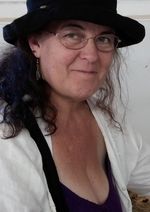The Last Bumblebees

From our floor to ceiling windows in the family room, we often watched a great blue heron standing knee deep in water, stealthily spearing fat catfish and tossing them on the bank. Fluttering his fantastic wings he would spear them again and toss them down his long gullet. After the triumphant feast he would puff out his feathers and strut around, preening and grooming himself.
This past winter snowy egrets were migrating. Several mornings I saw them congregated like prophetic signs of good fortune, 4, then 7, then 8, and another day I counted 40.
We've lived here for three springs. Families of mallard ducks paddle the water and waddle the bank outside our window. We fed so many of them at one point that the grass was mashed senseless and we had to reseed. The enthusiastic quacking and faithful marching toward us when we opened the door made us laugh.
One day I heard my kids shouting, "The bumblebees, the bumblebees!" Thinking they meant we were being swarmed, I ran to the window expecting to see (what else?) bumblebees. Instead I saw a little gang of baby ducklings, mottled black and yellow. The children thought they looked like bumblebees and dubbed them such. Bumblebees they were dubbed - bumblebees are us-- bumblebees they is. Whatever!
The Canadian Geese are wonderful parents. The proud fathers stand guard constantly, arrogantly. His mate and goslings poke around the grass for delicious bugs or crumbs of thrown bread while he stands seriously, watching for danger. The mallards are less serious. They peck each other. The mothers fly at the first sign of danger and don't necessarily protect their babies. The fathers are more deadbeat; or they show occasional and non-committed interest.
This morning my husband and I opened the living room glass doors, and furtively tossed bread crumbs to the little mallard family that waddled up the bank for breakfast.
Now the owners of this rental house want to sell it, for more money than we can afford, so we are moving in two weeks. Having the chance to live in this house has given us a chance to live in touch with an aspect of nature many people never experience.
I think of the millions of displaced families who've moved from homes they didn't want to leave throughout history. If nothing else, I can leave this place learning compassion for other people who weren't ready to pull up roots from the place they call home. I'm so grateful we've been able to see the bumblebees one more time. They remind me of how the cycle of life continues despite human upheaval.
Kim lives in Maine, which is lovely, and where she continues her enthusiastic relationship with Art, Music, Nature, Books, Animals, Humor and Trees.


